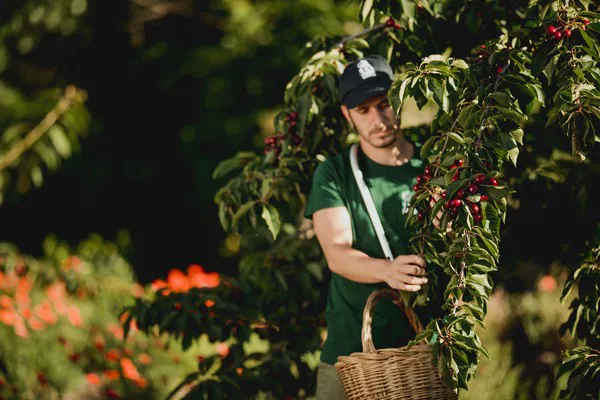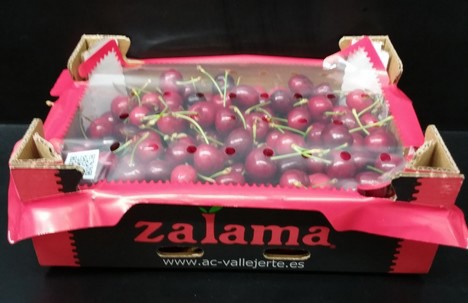The cherry harvest has just started in the Jerte Valley, a region in the Spanish province of Caceres which has become renowned in all of Europe for the production of this fruit. The region has the Protected Designation of Origin Cereza del Jerte, which has certified the quality of the fruit produced in its valleys since 1996. It is also where the largest cherry marketer in Europe, the Agrupación de Cooperativas del Valle del Jerte, is based.

“This year we started the campaign quite early with some small volumes around April 22. We had a very good start; it was clear that the markets were craving cherries, both nationally and internationally. However, last week's rains have taken a toll on the estimated harvest potential of the early varieties,” said Mónica Tierno, general director of this second-degree cooperative, which brings together 15 cooperatives from the Jerte and the La Vera valleys.
“The cherry trees of our cooperatives are cultivated at different altitudes, so the fruit becomes ripe at different stages. The riper fruits have been the most affected by the rain. There are areas in higher altitudes where the fruit was still ripening, and there’s where we are harvesting now.
Despite the fact that the weather in April has clouded the start of the campaign, a factor that has also affected other Spanish producing areas, the season's harvest forecast is still quite good, says Mónica. “At first, the harvest potential had been estimated at around 24 million kilos. Obviously, this has been reduced by the rain, but even taking into account the possibility of more rains, this season's production should at least reach approximately 20 million kilos.”
“It is true that right now the quality is poor overall”, says the general director, “and in any case, the first varieties are also usually softer, although they have their niche in the market because they are the first and everyone is eager to try them. We are now awaiting the arrival of higher quality, harder varieties to be able to supply the markets with greater guarantees. We will start with them this weekend, and after next week we will start having larger volumes,” she says.
Second campaign in pandemic times
This will be the second campaign for Jerte cherries since the pandemic started; a difficult context in which the same challenges still exist, but which the sector will face with the experience acquired last year.
“It is clear that the pandemic continues to take a toll, because in Spain's case, there are many sectors linked to tourism which are not working at full capacity, and this means that some sales channels are more affected. Besides, consumption habits have also changed and many people have stopped eating out and opted to eat at home, worrying more about their health. Since we operate both with wholesalers and large stores at both national and international level, we see that sales are offset, because although they are reduced in some, they increase in others,” says Mónica. “Let's hope that, as we saw last year, there will be a period of some relative normality in the summer, especially in June, which is when we expect most of the cherry volumes. For us, it is interesting to have as many sales channels as possible.”
Mobility has also been limited by the health crisis and this has marked the development of the agricultural sector's activity. “In our case, the harvest is mostly carried out by the producer families and we don't depend as much on external labor,” says the professional. “When it comes to preventing contagion, we already have last year's experience with the protocols that were implemented and which will remain in force this year. It is clear that contagion cannot be fully prevented, but what matters most is to have an effective protocol to be able to detect, identify and isolate any cases.”
Europe's largest cherry trader
The Agrupación de Cooperativas del Valle del Jerte accounts for around 80% of the region's cherry production and is the largest cherry marketer in Europe. Spain and other EU markets are the main destinations for Extremadura's fruit, which competes in them against the production of other origins; not only from third countries such as Turkey, which has a strong presence in Central Europe and Scandinavia, but from other European countries, such as Italy (whose cherry production has been affected by extreme climatic conditions) and Spain itself, says Monica.

“There is great competitiveness in the markets, because the acreage is growing constantly in different areas of Spain and the rest of Europe. For this reason, we care a lot about the quality and service we offer to our customers,” she says. “This year we have a new optical calibrator (with this one, we already have 5), and we continue to adapt our machinery and acquire new one to adapt to different market demands in terms of formats, as well as to increase our capacity to react and be always ready when our clients need us.”
In addition to the markets of the European Union, the Agrupación de Cooperativas del Valle del Jerte exports cherries by air every season to different overseas destinations, including the United Arab Emirates or Hong Kong. “Although we continue to grow in such destinations, the European market remains our first option, and distant countries usually receive smaller volumes. These markets involve greater risks, and we prefer to ship by air to minimize them.”
In any case, the protocol to allow the export of Spanish cherries to China is currently being negotiated. This has been requested by the sector, as it would open up a very interesting opportunity to export to a country with a high demand for this fruit, as shown, for example, by the Chilean cherry export figures.
For more information:
Mónica Tierno Díaz
Agrupación de Cooperativas del Valle del Jerte
Ctra. Nacional 110, km 381
10614 – Valdastillas, Cáceres, Spain
T: +34 927 471070
monicatierno@ac-vallejerte.es
www.ac-vallejerte.es
